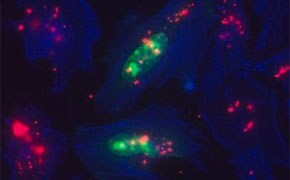Transfection & Gene Editing

Transfection is the process of introducing nucleic acids into eukaryotic cells. Cells can be stably transfected for the integration of DNA into their genome, or transiently transfected for protein expression of temporary duration. Chemical, physical, and biological methods are used to transfect cells, enabling the study of gene function and expression within a cellular environment. Applications include gene therapy, generation of induced pluripotent stem cells (iPSC), gene silencing by RNA interference (RNAi), and the production of therapeutic antibodies and proteins.
Related Technical Articles
- Transfection is the introduction of DNA, RNA, or proteins into eukaryotic cells and is used in research to study and modulate gene expression. Thus, transfection techniques and protocols serve as an analytical tool that facilitates the characterization of genetic functions, protein synthesis, cell growth and development.
- Browse our convenient transfection reagent selection guide to match the best reagent for your specific cell line and application needs.
- Automation is used for many applications to reduce variation caused by manual handling and to obtain reproducible results in high-throughput assays. High-throughput applications, such as knockdown studies or target screenings, often include cell transfection.
- Small inhibitory RNAs (siRNAs) have become the focus of interest in many laboratories. For the first time, these molecules offer an easy way to knock down the expression of selected genes in mammalian cells without having to resort to classical gene knockout techniques.
- Get tips for handling lentiviruses, optimizing experiment setup, titering lentivirus particles, and selecting helpful products for transduction.
- See All (20)
Related Protocols
- Our Universal Transfection Reagent is a unique formulation of a proprietary polymer blend used for transient and stable transfection of nucleic acids into various eukaryotic cell lines and hard-to-transfect primary cells. This is a fast and easy protocol is compatible with serum, serum-free medium and antibiotics.
- Protocols for Transfecting Common Cell Lines with X-tremeGENE™ Transfection Reagents
- Cell preparation for transfection Plate cells approx. 24 hours before transfection making sure cells are at optimal concentration (70 – 90 % confluency).
- Calcium Phosphate Transfection Kit Protocol
- Product manual provides detailed protocol for easy DNA transfection.
- See All (22)
Common Transfection Methods
- Lipids and liposomes: Cationic lipids form liposomes containing DNA or RNA for delivery. These liposomes fuse with the cell membrane and release nucleic acid into the cell.
- Calcium phosphate: Calcium phosphate facilitates the binding of DNA to the cell surface, allowing genetic material to enter the cell by endocytosis.
- Cationic polymers: In polymer-based transfection, exogenous DNA forms complexes with cationic polymers such as polyethylenimine (PEI) that enter host cells by endocytosis.
- Lentiviral transduction: Cells are infected with modified lentivirus vectors, which convert their viral RNA to double stranded DNA for integration into the host genome for delivery.
- Microinjection: Target cells are first positioned under a microscope. Nucleic acid is then directly injected into the cytoplasm or nucleus using a fine glass capillary needle.
- Electroporation: Cells are exposed to high-intensity electric current that destabilize membranes, increasing their permeability for gene delivery.
Transfection is routinely used in gene editing and gene silencing techniques that have enhanced our understanding of complex biological processes and enabled the use of gene therapy to treat disease.
- CRISPR-Cas systems exploit a bacterial defense mechanism that uses genetic CRISPRs (Clustered Regularly Interspaced Short Palindromic Repeats) coupled with Cas (CRISPR-associated) endonucleases to cut genomic DNA at targeted positions and remove or replace genes in vivo.
- Engineered zinc finger nucleases (ZFNs) are constructed of DNA binding domains and endonucleases and cleave DNA at targeted sites for gene editing.
- RNAi reagents such as short hairpin RNAs (shRNAs) and small interfering RNAs (siRNAs) limit gene transcript levels for gene silencing by either suppressing transcription or activating sequence-specific RNA degradation processes.
To continue reading please sign in or create an account.
Don't Have An Account?